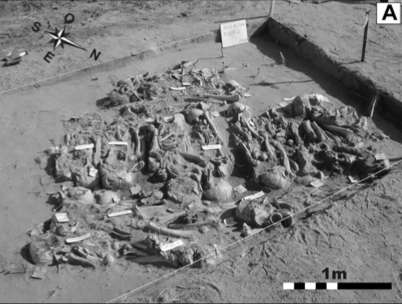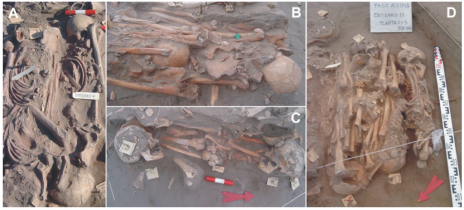Prehistoric Secondary Burial in Argentina
Katy Meyers
Source - http://www.bonesdontlie.com/
Regeneration, replacement and restoration are common themes in funerary rites. The fear of death and the end is mediated by a number of human societies by focusing on renewal on life. This can manifest in rituals, feasting, burial locations and even the treatment of the body. Egyptians preserved the body in order to assure passing onto the next life, and in many Indian cultures the body is cremated in order to free the soul for its next life. Manipulation of the bones and body has been practiced since humans began burying. Some of the earliest burials from the Middle Paleolithic show signs of being coated with red ocher. Preparation of the corpse for the afterlife is important to many cultures. However, the ways that it is done and the reasons why vary drastically. Martinez et al. (2012) look at the manipulation of bones in the Final Late Holocene (ca. 1000–250 years BP) in the Colorado River valley of Argentina in order to determine the type of practice and why it was being done.

Martinez et al. 2012 Bundle Burials
In the Late Holocene period (3000-1000 BP) there was little trade, settlements were temporary, and a lower population density. These burials are primarily single primary inhumations that are disposed in isolated areas or around domestic sites. In the Final Late Holocene there were a number of major cultural and economic changes including population growth, inter-ethnic contact, expanded trading networks at local and regional levels, increased territoriality, and spatial circumscription. In this period there is also a change to formal bounded cemeteries with secondary burial and manipulation of the body. In this study, the goal is to understand how bodies were manipulated and what this meant to the culture.
Martinez et al. (2012) examine two sites from the region that have evidence of secondary burial. The first is La Petrona, which has two primary and two multiple secondary burials. The first multiple burial has two adult females and one adult of undetermined sex. There is no anatomical articulation between the bones, however there is a pattern in the bone distribution: skull and pelvises at each end, long bones along the sides, and other bones (vertebrae, ribs, bones of the hands and feet) in the middle. The second multiple burial includes one adult female, one undetermined sex adult and an infant. The placement and lack of articulation is similar to the first bundle burial, however there is some evidence of red coloring along the bones. The two primary burials, which contain an adult female in one and unknown adult in the other, shows evidence of removal of bones, including vertebrae and portions of the pelvis. Traces of defleshing and scraping were found on most of the remains from this site. The evidence of defleshing and scraping suggests that the bodies were manipulated prior to complete skeletonization. While the stage of disarticulation is unknown, it could have happened early on to remove flesh or as a way to ease transport and organization of remains.

Martinez et al. 2012 Bundle Burials
The second site is Paso Alsina 1. There were a total of ten multiple secondary burials with a minimum number of 56 individuals based on skulls. This group represents a fairly normal demographic curve with similar numbers of males and females, and a variety of ages. There was a pattern in the way that these ten burials were structured: one to three skulls were found on the ends, bones of the pelvic and shoulder girdle were associated with the skulls, long bones on the sides, and ribs aligned symmetrically on top. Other portions of the skeleton like the vertebrae were found less frequently in these burials. There was little to no articulation between bones. Cut marks were found on the majority of the remains, although most were on long bones. Some of the bones show red, yellow and green coloring likely caused by pigments that was placed on the bone after defleshing.
Mortuary rituals have the power to produce and reproduce identities, as well as strengthen social relationships and collective social memory. The manipulation of human remains following death is argued to be due to a society’s need to reconnect with their ancestors in order to make claims to resources. Given the amount of cut marks and extensive coloration of the bone, Martinez et al. (2012) argue that the bodies must have been processed by a large group, showing community participation in the activity. By having the community come together to bury their dead in one location, removing individual identity by breaking their bodies down into pieces, they reinforce the identity of the group. In creating these group burials and disarticulating bones they are maintaining their ancestors and community identity.
While we cannot know exactly the purpose behind the manipulation of remains in this period, the conclusions drawn by Martinez et al. (2012) arre logical. This was a period of increased competition over resources due to population growth, and increased sedentism. These factors create competition over space. In order to make claims to resources, communities need to assert their rights to a place. What better way to do that than burying your dead in formal cemeteries on your land. The next question then is why they needed to break the bodies down into parts and have mass graves. With increasing competition between communities you also get competition within. In order to strengthen ties within the group and prevent problems of status, you can bury your dead all together. While equality in death doesn’t mean equality in life, it does symbolize the importance of the group over the individual and strengthen group ties.
Works Cited
Martínez, G., Flensborg, G., & Bayala, P. (2012). Human corpse manipulation and the body as symbol: A case study from the Eastern Pampa–Patagonia transition (Argentina) during the Final Late Holocene Journal of Anthropological Archaeology, 31 (2), 215-226 DOI: 10.1016/j.jaa.2011.12.002